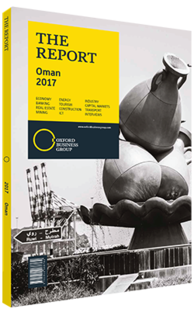Securities & Investment Company Oman banking market analysis
The Omani banking sector comprises a total of 16 conventional banks, of which seven are locally incorporated and nine are foreign. Conventional banks in Oman have a network of 468 branches and 1088 ATMs. Alongside conventional lenders, there are also two fully fledged Islamic banks that together have a market share of around 10% by assets. Bank Muscat is the largest institution with a market share of around 45% by assets. It is also one of the biggest listed firms on the Muscat Securities Market.
Environment
The year 2016 has been a challenging one for the banking sector in Oman. The plunge in oil prices that started in June 2014 has caused economic growth to slow down materially. The IMF expects real GDP to expand by 1.8% in 2016 and 2.6% in 2017, down from 3.3% in 2015 and 2.9% in 2014. The macroeconomic slowdown has put pressure on banks’ liquidity, cost of funding, capital adequacy and credit quality. Net profit of the six largest banks fell by 5% in the nine months to September 2016 as compared to the same period of the previous year. The drop was caused primarily by a decline in non-interest income, a rise in provisions, an increase in cost of funding and compression in net interest spreads.
However, despite macroeconomic weakness, Oman’s banking sector achieved robust credit growth of 11.4% to OR21.7bn ($56.4bn) by August 2016. Deposits increased by 6.3% to OR20.7bn ($53.8bn) over the same period. Omani banks are well capitalised with sector capital adequacy at around 16%, above the regulatory minimum set by the Central Bank of Oman (CBO). Asset quality has also remained strong as the non-performing loans (NPLs) ratio is low and provisions fully cover NPLs on average. However, liquidity has come under pressure as loans are growing at a faster pace than deposits. This is largely because the Omani government has been withdrawing deposits from the banking system to compensate for lower oil revenues in recent years.
Financing
Under tight liquidity conditions, several large Omani banks have relied extensively on foreign liabilities as a source of funding. Since 2014 local lenders have raised capital in the form of dollar-denominated euro medium term notes (EMTN) and perpetual bonds to position themselves for future growth and comply with Basel III capital adequacy requirements. Bank Muscat issued a five-year $500m EMTN in 2016 at a coupon rate of 3.75%; Bank Dhofar issued a $300m perpetual bond in 2015 at a rate of 6.85%, and National Band of Oman issued a $500m, five-year bond with a coupon of 3.125% in 2014.
Market Plays
Share prices of Omani banks have declined significantly in the wake of low oil prices. Large banks such as Bank Muscat and National Bank of Oman now trade at significant discounts to book value. Bank Muscat’s share price fell by 43% from a peak in October 2014 to September 2016. The decrease was primarily attributable to foreign selling. Foreign ownership in Bank Muscat dropped from about 25% in September 2014 to around 14% in September 2016. The declines in share prices are overdone as the banks continue to maintain strong balance sheets and healthy ratios. Despite short-term weakness in profitability, long-term fundamentals are robust and currently low stock prices offer attractive opportunities for long-term investors.
In October 2016 merger talks between Bank Dhofar and Bank Sohar came to an end after the two sides were unable to reach agreement on certain issues related to the merger. The banks had been exploring the possibility of consolidation for more than three years and had even agreed on a merger share-swap ratio of 1.29 in June 2016. The combination would have created the second-largest bank in the sultanate. Consolidation in the current operating environment makes sense, as smaller banks lack sufficient scale to expand and mergers can encourage banks to seek out synergies and cost savings.
You have reached the limit of premium articles you can view for free.
Choose from the options below to purchase print or digital editions of our Reports. You can also purchase a website subscription giving you unlimited access to all of our Reports online for 12 months.
If you have already purchased this Report or have a website subscription, please login to continue.

